
In Homs and Palmyra, life after the destruction
(MENAFN- Brazil-Arab News Agency (ANBA)) Alexandre Rocha
Homs, Syria – Homs is Syria's third biggest city, following Aleppo and Damascus. Located some 170 km north of the capital, it has long had crucial economic, geographic and strategic relevance. It sits halfway through the two biggest metropolises, in a predominantly agricultural area near the Orontes River, on the east end of the only natural connection between the country's heartland and the Mediterranean – the passageway between mountains known as Homs Gap or Gateway to Syria.
It's been a significant trade hub since Antiquity, at which point it was known as Emesa, and it wasthe birthplace of two Roman emperors . An industrial hub prior to the war that began in 2011. Homs is the subject of ANBA's third special report on Syria.
The agency visited the city on August 30 with a group of journalists from various countries, at the invitation of Syria's Ministry of Tourism. Homs was a major stronghold for the armed insurgency against the regime during wartime, especially from 2011 to 2015.Unlike Damascus , where the fighting happened mostly in the suburbs, here it took place in the downtown areas, which are currently controlled by the government.

The mosque, pre-restoration
One of Homs' landmarks is the Khalid Ibn Al-Walid Mosque (pictured at the top of this story), built in the early 20th century in honor of the eponymous Arab general who used the be a companion of prophet Muhammad. Also known as Sword of God, Khalid Ibn Al-Walid secured the conquest of Syria by Arab Muslims in the Battle of Yarmouk, in 636 AD., with the defeat of the Byzantine army. He died in Homs in 642 AD., and his grave is within the mosque.
The temple sustained severe damage during recent fighting but has been completely restored. The surrounding Khalidiya neighborhood and other downtown areas in Homs, on the other hand, are still in ruins.
Homs' Department of Religious Affairs chief, sheikh Issam Al-Masri, said the place has been a Muslim pilgrimage site since the Middle Age. Although the mosque is relatively new, older buildings have been erected around Khalid Ibn Al-Walid's mausoleum throughout the centuries, and later demolished to make room for new projects. 'This is where the people of Homs have their celebrations,' said Masri in an interview inside the mosque.
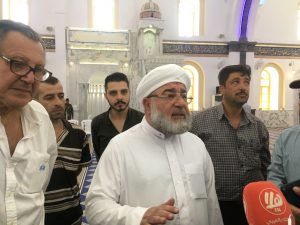
'At first there were no weapons, but they began cropping up fast'
He explained that the uprising here began with anti-regime demonstrations in 2011. 'At first there were no weapons, but they began cropping up fast, lots of heavy weaponry,' he said.
The sheikh recalled the distress and grief as armed groups seized portions of the city. He said he joined talks to persuade these groups to leave Homs. 'Yes, of course I joined, because I'm chief of the Department of Religious Affairs,' he argued. 'Some of them accepted [an agreement] and some didn't. The ones that accepted are still here; the others got driven out,' he said.
The body count in Homs was high. The UN estimates some 400,000 were killed in all of Syria during the war. 'Someone got killed or wounded in virtually every family in Syria and in Homs,' said Masri.
(Story continues after photo gallery)




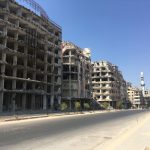
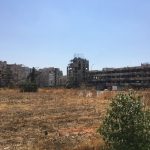
Brazilian
A Brazilian who lives in Homs, Renata Issa reminisced on the predicament of being caught in the middle of the fighting. A daughter to Syrian parents born in Curitiba, Paraná, she decided to move to Syria in early 2011 with her husband – a Syrian engineer from Homs – and their two children. 'He wanted to return to his homeland, and we wanted to raise the kids in a safer place where crime wasn't as rampant [as in Brazil],' she said. At that point, the war was yet to begin. 'The Arab Spring protests were going on, but we couldn't tell what was going to happen, or how far it would go,' she went on.
When the crisis began, the couple was unsure whether to return to Brazil or not. 'I had sold my practice and ended my activities in Brazil, so we decided to wait,' said Issa, who's a dentist. She said her neighborhood in Homs wasn't directly hit, but as things took a turn for the worse, there were explosions near her home, people got killed, and she could see soldiers firing from a nearby rooftop towards downtown.
'It was scary, the noise, the bombs, I wanted to pack up and go back to Brazil,' she said. The family decided to move into the village where Issa's in-laws, in the Tartus area along the Mediterranean coast. 'Many families moved into that area. Everyone that could, did,' Issa explained. They were there for a year and a half. 'Until things cooled off,' she said. Now, the family is back in Homs, where she has her own practice.
Palmyra
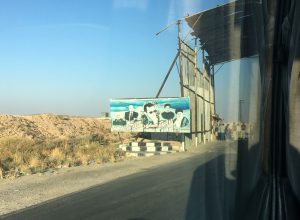
A checkpoint along the road and a poster of Bashar Al-Assad with allied leaders
ANBA and the other journalists left Homs for Palmyra, the archaeological jewel of Syria, 164 km east of the metropolis. Along the way was the strongest military presence of our entire stay in Syria, including checkpoints and camps on both sides of the road.
The oldest references to Palmyra date from the 19th century BC. The name, however, was given by the Romans, who conquered the city in the 1st century AD., under emperor Tiberius, and means City of Palms. The original name, Tadmor, is employed until this day, and it also designates the modern city that's been built next to the ruins.
Palmyra was a highly relevant city in ancient times, since it sat on an oasis along the main East-West caravan route. One of its best-known figures is queen Zenobia, who rose to power around 268 BC, conquered most of Asia Minor and declared the independence of Rome. Afterwards, emperor Aurelian (270-275 AD) regained control.
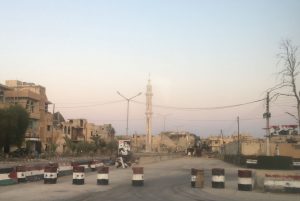
The modern Tadmor, adjoining the ruins of Palmyra
The ruins of Palmyra and the modern city of Tadmor were invaded by the self-proclaimed Islamic State in 2015. Before being driven out in 2016 by the Syrian army and its allies, the group dynamited many of the monuments, including the Arch of Triumph – the gateway to the city's main colonnade – and part of the amphitheater. In 2013, Palmyra got listed as World Heritage in Danger by the United Nations Educational, Scientific and Cultural Organization ( UNESCO ).
The group of media professionals arrived at the historical site under a majestic sunset. The place was full of people, families, young people and children. The Homs Orchestra was slated to perform in the ancient amphitheater that night.
(Story continues after photo gallery)
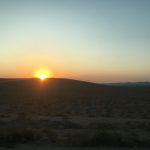
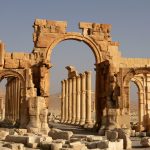


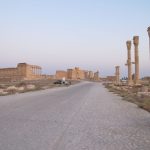
Young people taking selfies amid the landmarks soon became interested in the foreign journalists and started conversations. In Syria – and in the Arab world at large – people are usually hospitable, and quick to chat.
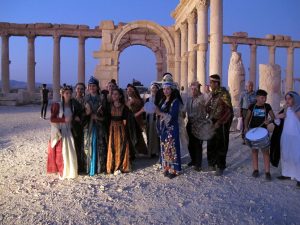
Young people get ready to step into the arena
Two of them said they live in the modern Tadmor but fled to Homs with their families when the terrorists arrived. One of them, now aged 16, was only eight when the war began.
There was fighting in Tadmor, and the damage is apparent. The place seems uninhabited, and the historical site in Palmyra was closed to visitors – an exception was made that night because of the concert. People came from other cities to watch.
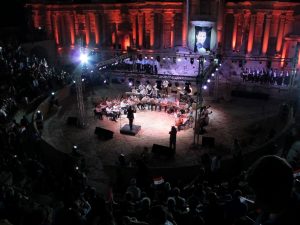
A concert by the Homs Orchestra
The crowd took to the stands bearing Syrian flags and other national symbols. The orchestra performed with singers in front of the original stage, whose pediment was destroyed (watch the video at the end of this story). In the background, a portrait of president Bashar Al Assad, where Zenobia used to rule.
One of the guides escorting the journalists said with a touch of nostalgia that in the eight years leading up to the war, he'd bring tourists to Palmyra every Tuesday without fail. That wasn't the case in the eight years that followed.
The concert ended, but the night was far from over. Read all about it in ANBA's fourth report on Syria this Friday (13).
*ANBA traveled at the invitation of Syria's Ministry of Tourism. Translated by Gabriel Pomerancblum
.jpg)
Legal Disclaimer:
MENAFN provides the
information “as is” without warranty of any kind. We do not accept
any responsibility or liability for the accuracy, content, images,
videos, licenses, completeness, legality, or reliability of the information
contained in this article. If you have any complaints or copyright
issues related to this article, kindly contact the provider above.

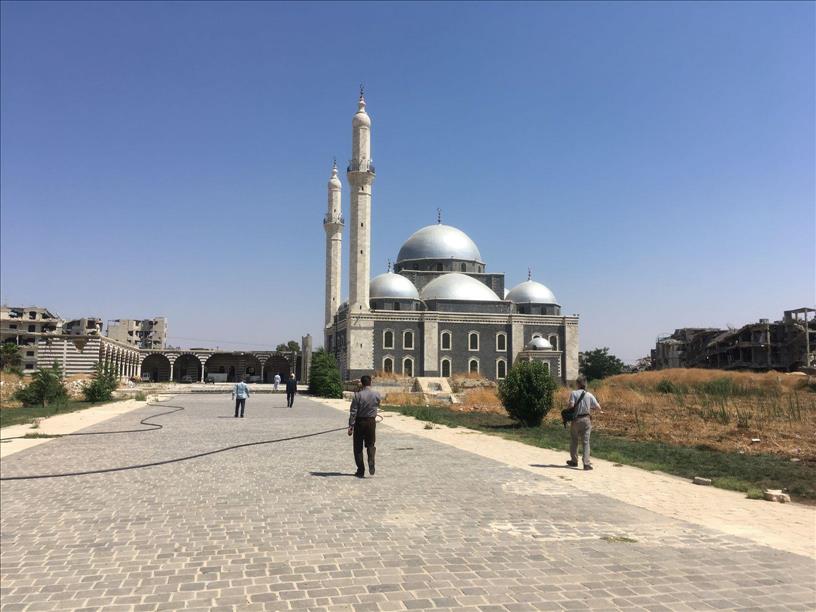
















Comments
No comment